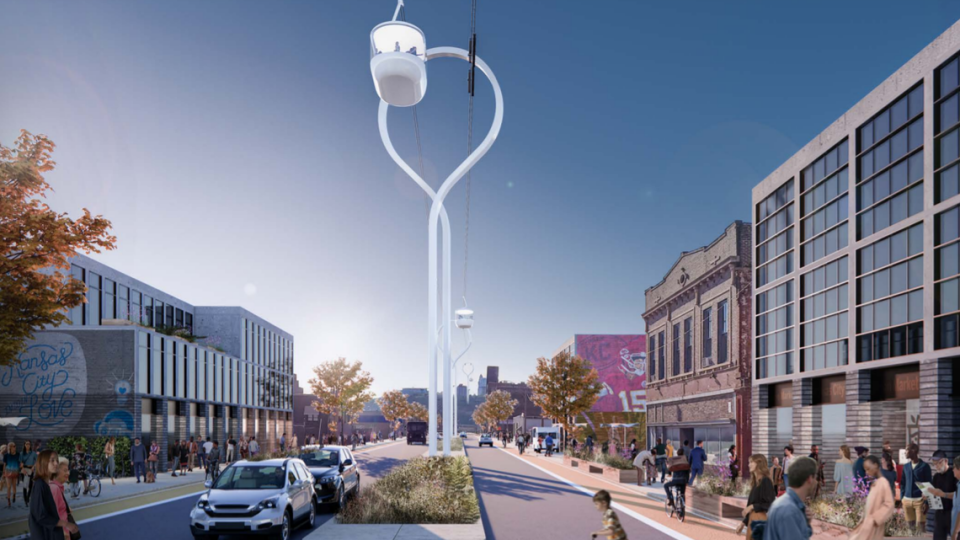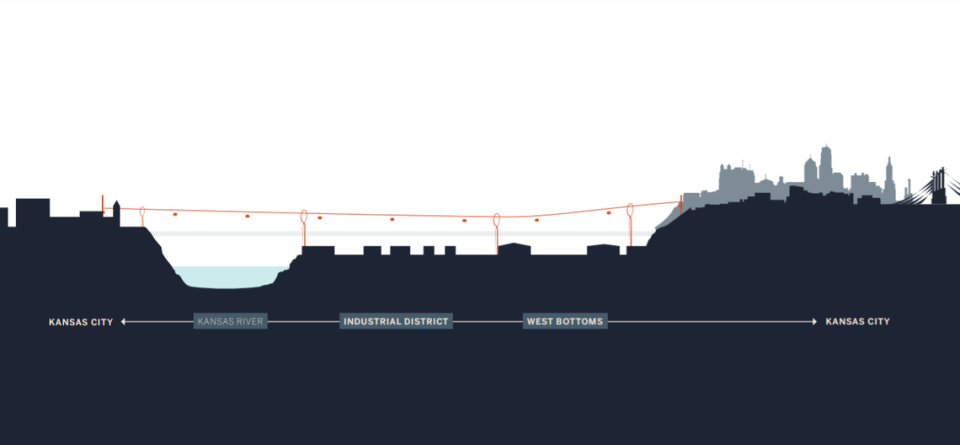KCK eyes overhead gondola as a new means of transit to connect to downtown Kansas City
At one time, downtown Kansas City was well connected to downtown Kansas City, Kansas.
Over the years, there were trains, ferries and streetcars that allowed people to easily move across the Kansas River and across state lines.
But those local connections deteriorated with the arrival of the intercontinental railroads and the interstate highways, said Gunnar Hand, director of planning and urban design at the Unified Government of Wyandotte County/Kansas City, Kansas.
He’s now eyeing a novel way of reconnecting the respective cores of the two Kansas Cities. Hand and other planners are proposing an aerial lift that would move people in gondolas far above the ground.
While no routes have been proposed, he envisions a “bluff-to-bluff” crossing that would move people from Case Park in Quality Hill to St. John’s Park in Strawberry Hill, with a potential stop in the West Bottoms.
“Not everybody knows there’s a downtown KCK,” said Hand. “So for us we think there’s excellent opportunity to change the narrative about what downtown Kansas City, Kansas, is as we are currently working hard on our own renaissance.”
So far, the idea is just that. No funding has been committed and no in-depth planning has occurred. The idea for an overhead passage started with the county’s mobility planning process, which is examining how to create a future transit system that is less reliant on cars.
Specific costs are unknown, but Hand said a gondola is more affordable at crossing a river than light rail. On average, the gondola would cost $25 million per mile, about half the $50 million per mile it took to build the Kansas City Streetcar’s starter line downtown.
Hand said most options are on the table. An aerial lift could resemble a Colorado ski lift with room for a few people. Or it could carry large cars full of passengers similar to the Roosevelt Island Tramway, which carries commuters and tourists between Manhattan and Roosevelt Island in the East River in New York.
One thing that’s clear, though, is that Wyandotte County wouldn’t endeavor to build a gondola on its own.
“It is clearly a bi-state project,” he said. “It clearly cannot happen without Kansas City, Missouri and Kansas City, Kansas.”
City leaders in Kansas City could not immediately be contacted for comment.
While the costs would be in the millions, Hand said this is a good time to consider such an ambitious project. The recent passage of President Joe Biden’s $1 trillion infrastructure bill will make new revenue sources available to cities and states across the country.
Such a mode of transportation would no doubt prove a destination in itself, allowing locals and tourists alike to see Kansas City from a new vantage point. But Hand said it could also connect currently separate bike and pedestrian trails in Kansas and Missouri. And it would make it easier for workers and residents to reach the much more affordable real estate in downtown Kansas City, Kansas.
Primarily, though, it would reconnect two sister downtowns that have remained largely disjointed.
“I think there’s power in that story,” Hand said.
For the last year, Hand has been floating a 15-page preliminary study about the concept. It was compiled with the help of his former employer, Skidmore, Owings & Merrill, a Chicago design firm and New York-based HR&A Advisors.
“The intent of this document is to set a bold vision for our future connectivity,” it reads, “that both sparks the imagination of and elevates the public discourse around this new, regional mode of transportation.“
HR&A Advisors has also worked on another transformative project in Kansas City, Kansas. That firm pushed for the Unified Government’s involvement in an ambitious plan to redevelop the 1905-era Rock Island Bridge into an events venue with bars, coffee shops and restaurants.
The Unified Government agreed to lease the old railroad bridge to developer Flying Truss LLC and will invest $2 million into the redevelopment.
Work is expected to commence soon on the bridge, which sits just behind Hy-Vee Arena in the Stockyards District of the West Bottoms. Developers hope to open the long-shuttered bridge in the spring of 2023.


